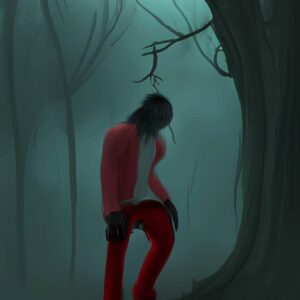The Legend Of Kapre: A Filipino Myth
28th March 2023
Categorized Under: Myths and Legends from Around the World
Comments (0)
FILIPINO LEGENDS AND LORE: STORIES OF THE SUPERNATURAL AND MYSTERIOUS
Filipino folklore is a rich and diverse collection of myths, legends, and superstitions that have been passed down through generations of Filipinos. The stories are deeply rooted in Filipino culture and history and often reflect the beliefs and values of the people. Many of the myths and legends are centered around supernatural creatures, such as Aswang (a witch-like creature that feeds on human flesh), Tikbalang (a half-man, half-horse creature), and duwende (a mischievous dwarf-like creature).
One of the most well-known creatures in Filipino folklore is the Kapre. Other famous creatures include the Manananggal, which is a creature that can detach its upper body and fly. Another, is The Tiyanak, a demon-like baby that lures people into danger. And The White Lady, a ghostly figure often seen near bodies of water.
Filipino folklore is also rich in legends that explain the origins of natural phenomena, such as the creation of the world and the stars. Many of these legends involve gods and goddesses, such as Bathala (the supreme god), Maria Makiling (the goddess of the mountains), and Anitun Tabu (the goddess of wind and rain).
Filipino folklore is deeply ingrained in the country’s culture, and many Filipinos still believe in and practice various superstitious beliefs and traditions. For example, having a “Pamahiin” (superstition) about certain days, numbers, or actions is common. Many Filipinos also consult “Manghuhula” (fortune tellers) and “Albularyo” (folk healers) for guidance and remedies.
Overall, Filipino folklore is a fascinating and intricate part of the country’s culture and history, and continues to be passed down through generations.
THE LEGEND OF KAPRE: A FILIPINO MYTH
According to Filipino folklore, the Kapre is a giant, hairy creature with a muscular build. It is said to stand at around 7 to 9 feet tall, although some stories claim that it can grow to be even taller. It is usually depicted as having dark skin and red, glowing eyes that can pierce through the darkness of the night. This creature is often seen wearing traditional Filipino clothing, such as a white shirt and red pants. It is also usually depicted holding a tobacco pipe, which it uses to smoke its favorite brand of tobacco. Also, it emits a strong, musky odor that can be smelled from far away, which is often used as a sign of its presence.
One interesting aspect of the Kapre’s appearance is its ability to change its size and shape. Some stories claim that it can shrink itself down to the size of a regular human, while others say that it can transform into various animals or even inanimate objects like trees or rocks. This ability to shape-shift adds to the Kapre’s mystique and makes it even more unpredictable and mysterious.
The Kapre is known for its mischievous and playful personality, but it can also be quite temperamental and unpredictable. It is often portrayed as a trickster, fond of playing pranks on people who venture into the forests or fields where it lives. Some of the pranks that the Kapre is known to play include tying people’s shoelaces together, hiding their belongings, or leading them astray.
Despite its playful nature, the Kapre is also known to be quite moody and can become aggressive if it feels threatened or offended. It is said to have a short temper and can easily become angered if it is disrespected or disturbed. Because of this, many Filipinos are careful to ask for his permission before venturing into the forests or fields where it is said to reside, and they often leave offerings of tobacco or other gifts as a sign of respect. It is also believed to be protective of the environment and the creatures that live in it, often scaring away hunters and loggers who are attempting to cut down its tree.
In some stories, the Kapre is portrayed as a lonely creature, longing for companionship but unable to find it because of its intimidating appearance. It is said to have a soft spot for children and has been known to befriend them and play games with them in the forests. However, it is also known to kidnap children who play too close to its tree, but in general, it is more of a trickster figure who enjoys messing with people’s minds.
Since Kapre is a mythical creature, it cannot be killed or die in the traditional sense. In Philippine folklore, Kapre is believed to be a supernatural being with powers beyond human understanding. It is often depicted as an immortal creature that can live for centuries or even millennia. That being said, there are stories of humans who have tried to kill or harm Kapre in some way. However, these attempts are usually unsuccessful and often result in the humans suffering some kind of retribution from the creature. In some other stories, Kapre is said to be vulnerable to certain kinds of plants or herbs, but these are usually difficult to find or use. Generally speaking, Kapre is seen as an untouchable figure in Philippine folklore, and people are advised to show it respect and deference rather than attempting to harm or kill it.
Kapre is a well-known and beloved figure in Filipino folklore, and its legend has been passed down through generations. Today, Kapre continues to be a popular subject in Filipino literature, music, and art and has become a symbol of Philippine culture and identity.
THE RED-EYED GIANT: A KAPRE’S STORY
According to some people from the Philippines, once, three friends decided to explore a nearby forest. As they walked deeper, they suddenly noticed a large, dark shape in the distance. As they got closer, they realized it was a huge tree with an enormous figure perched on one of its branches. The figure was smoking a large tobacco pipe and glowing eyes. The friends were scared, but they decided to investigate further. As they approached the tree, they saw that the figure was a Kapre. The Kapre stared at them with glowing eyes and began to laugh, blowing smoke in their faces. They tried to run away but got lost in the forest. The Kapre continued to play tricks on them, leading them in circles and making them feel disoriented. Finally, after what felt like hours, the Kapre let out a roar and disappeared, leaving the friends alone in the forest. Exhausted and scared, the friends eventually found their way to their village. They never forgot their encounter with the Kapre and warned others not to venture too deep into the forest.
This is just one of many stories about Kapre, and it shows how the creature can be mischievous and unpredictable. While some stories depict Kapre as scary and dangerous, others show it as a figure who is protective of the forest and its inhabitants.
SOME OF THE PRANKS THAT KAPRE IS SAID TO PLAY ON HUMANS
-
Disorienting people: Kapre can disorient people who get too close to its tree by making them feel dizzy, confused, and lost.
-
Hiding things: Kapre is known to take things that belong to humans, such as hats or tools, and hide them in hard-to-find places.
-
Scaring people: Kapre is said to enjoy scaring people by appearing suddenly or making eerie noises. It can also make objects move on their own or create other supernatural phenomena.
-
Leading people astray: Kapre can lead people astray in the forest or countryside by creating illusions that trick them into following the wrong path.
These are just a few examples of the pranks that Kapre is known to play on humans. In some stories, Kapre can also be helpful to those who show it respect and kindness, but it is generally considered mischievous and unpredictable.
A FEW LESSER-KNOWN ASPECTS OF THE KAPRE LEGEND
-
Gender identity: While Kapre is typically depicted as a male figure, there are some stories that suggest Kapre can also appear as a female figure.
-
Protective nature: While Kapre is often depicted as a prankster or a dangerous creature, some stories suggest that it can be protective of the forest and its inhabitants. In these stories, Kapre is known to scare away hunters and loggers who are harming the environment.
-
Association with tobacco: Kapre is often depicted as smoking a large tobacco pipe. Some scholars suggest that this association with tobacco may be a metaphor for the indigenous peoples’ relationship with nature and the environment.
-
Variations in appearance: While Kapre is typically depicted as a tall, dark, and hairy figure with glowing eyes, there are variations in its appearance across different regions and communities in the Philippines. Some stories describe Kapre as having wings or horns, for example.
Related Posts:
Kidsinco’s Myths and Legends from Around the World
Kidsinco’s Complete List of Playscripts
Please read our Terms of Use
Instagram: @kidsinco
Tags: Filipino folklore, Filipino myth, The Kapre myth



